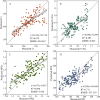Estimating photosynthetic characteristics of forage rape by fusing the sensitive spectral bands to combined stresses of nitrogen and salt
- PMID: 40212875
- PMCID: PMC11983616
- DOI: 10.3389/fpls.2025.1547832
Estimating photosynthetic characteristics of forage rape by fusing the sensitive spectral bands to combined stresses of nitrogen and salt
Abstract
Leaf gas exchange and chlorophyll fluorescence parameters (PGE-CFPs), which respond significantly and quickly to environmental stresses, have been used to assess the early responses of crop physiology to stresses. Most spectral estimations only focus on crop photosynthetic characteristics under a single environmental stress. Thus, the methods proposed previously are not suitable for the estimations under combined stresses (i.e., nitrogen and salt). In this research, the leaf spectral features of forage rape (Brassica napus L.) under nitrogen stress (NSpe) and salt stress (SSpe) were fused to increase the accuracy of the spectral estimation of photosynthetic characteristics of forage rape under combined stresses in arid region of Xinjiang, China. The results showed that PGE-CFPs' spectral features were extracted with SPA (successive projections algorithm) after preprocessing. Among the SSpe- and NSpe-based models, the RF (random forest) models had higher estimation accuracy than the PLSR (partial least squares regression) and BPNN (backpropagation neural network) models. Specifically, the RF models had a PGE-CFPs estimation accuracy of 0.597-0.712, 0.640-0.715, and 0.377-0.461 under nitrogen stress (NS), salt stress (SS), and NS*SS, respectively. After fusing NSpe and SSpe, the accuracy in estimating PGE-CFPs of forage rape under NS, SS, and NS*SS were 0.729-0.755, 0.667-0.768, and 0.621-0.689, respectively. Then, the constructed models were further validated using field data, and the accuracy obtained was in the range of 0.585-0.711. Therefore, the feature fusion modeling method proposed has strong transferability and applicability. This research will offer a technical reference for crop photosynthesis monitoring at the early stage of environmental stresses.
Keywords: combined stresses; continuous wavelet transform; feature fusion; hyperspectral technology; photosynthetic systems.
Copyright © 2025 Wang, Wang, Lv, Cui, Shi, Song, Li and Zhang.
Conflict of interest statement
The authors declare that the research was conducted in the absence of any commercial or financial relationships that could be construed as a potential conflict of interest.
Figures











Similar articles
-
Improving the estimation accuracy of rapeseed leaf photosynthetic characteristics under salinity stress using continuous wavelet transform and successive projections algorithm.Front Plant Sci. 2023 Nov 14;14:1284172. doi: 10.3389/fpls.2023.1284172. eCollection 2023. Front Plant Sci. 2023. PMID: 38130483 Free PMC article.
-
Monitoring of Nitrogen Concentration in Soybean Leaves at Multiple Spatial Vertical Scales Based on Spectral Parameters.Plants (Basel). 2024 Jan 4;13(1):140. doi: 10.3390/plants13010140. Plants (Basel). 2024. PMID: 38202447 Free PMC article.
-
Hyperspectral-based Estimation of Leaf Nitrogen Content in Corn Using Optimal Selection of Multiple Spectral Variables.Sensors (Basel). 2019 Jun 30;19(13):2898. doi: 10.3390/s19132898. Sensors (Basel). 2019. PMID: 31262053 Free PMC article.
-
A study on water quality parameters estimation for urban rivers based on ground hyperspectral remote sensing technology.Environ Sci Pollut Res Int. 2022 Sep;29(42):63640-63654. doi: 10.1007/s11356-022-20293-z. Epub 2022 Apr 23. Environ Sci Pollut Res Int. 2022. PMID: 35460477
-
Estimation of Soil Organic Carbon Using Vis-NIR Spectral Data and Spectral Feature Bands Selection in Southern Xinjiang, China.Sensors (Basel). 2022 Aug 16;22(16):6124. doi: 10.3390/s22166124. Sensors (Basel). 2022. PMID: 36015885 Free PMC article.
References
-
- Barnes R., Dhanoa M., Lister S. (1993). Letter: Correction to the description of standard normal variate (SNV) and de-trend (DT) ransformations in practical spectroscopy with applications in food and everage analysis-2nd edition. J. Near Infrared Spectrosc. 1, 185–186. doi: 10.1255/jnirs.21 - DOI
-
- Breiman I. (2001). Random forest. Mach. learn. 45, 5–32. doi: 10.1023/A:1010933404324 - DOI
-
- Buschmann C., Langsdorf G., Lichtenthaler H. K. (2000). Imaging of the blue, green, and red fluorescence emission of plants: an overview. Photosynthetica 38, 483–491. doi: 10.1023/A:1012440903014 - DOI
LinkOut - more resources
Full Text Sources
Miscellaneous

